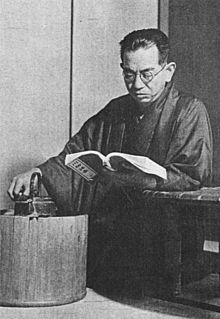Kogo Noda
Kōgo Noda | |
|---|---|
 Kōgo Noda in 1941 | |
| Born | November 19, 1893 |
| Died | September 23, 1968 (aged 74) |
| Resting place | Tama Cemetery[1] |
| Nationality | Japanese |
| Occupation | Screenwriter |
| Known for | Tokyo Story |
Kogo Noda (野田 高梧, Noda Kōgo, November 19, 1893 – September 23, 1968) was a Japanese screenwriter most famous for collaborating with Yasujirō Ozu on many of the director's films.
Born in Hakodate, Noda was the son of the head of the local tax bureau and younger brother to Kyūho, a Nihonga painter.[2] He moved to Nagoya after completing elementary school and later went to Waseda University.[2][3] After graduating, he worked for the city of Tokyo while also serving as a reporter for Katsudō kurabu, one of the major film magazines, using the pen name Harunosuke Midorikawa.[2] On the recommendation of a scriptwriter friend from junior high, Takashi Oda, he joined the script department at Shōchiku after the Great Kantō earthquake.[2][3] He soon became one of the studio's central screenwriters, penning for instance Aizen katsura (1938), one of its biggest pre-war hits.[2]
He is most known for his collaborations with Ozu, which began with Noda supplying the script for the director's first feature Sword of Penitence (1927), and led to such postwar works as Tokyo Story (1953), regarded by many critics as one of the greatest films of all time. He co-wrote thirteen of Ozu's fifteen post-war films.
When the Writers Association of Japan was formed in 1950, Noda served as its first chair.[4]
Selected filmography
[edit]| Year | Title | Director | ||
|---|---|---|---|---|
| Japanese Title | Rōmaji | English Title | ||
| 1927 | 懺悔の刃 | Zange no yaiba | Sword of Penitence | Yasujirō Ozu |
| 1929 | 和製喧嘩友達 | Wasei kenka tomodachi | Fighting Friends Japanese Style | Yasujirō Ozu |
| 会社員生活 | Kaishain seikatsu | The Life of an Office Worker | Yasujirō Ozu | |
| 1930 | 結婚学入門 | Kekkongaku nyumon | An Introduction to Marriage | Yasujirō Ozu |
| 進軍 | Shingun | Marching On | Kiyohiko Ushihara | |
| その夜の妻 | Sono yo no tsuma | That Night's Wife | Yasujirō Ozu | |
| エロ神の怨霊 | Erogami no onryo | The Revengeful Spirit of Eros | Yasujirō Ozu | |
| 足に触った幸運 | Ashi ni sawatta koun | The Luck Which Touched the Leg | Yasujirō Ozu | |
| 1931 | 東京の合唱 | Tokyo no gassho | Tokyo Chorus | Yasujirō Ozu |
| 1932 | 靑春の夢いまいづこ | Seishun no yume imaizuko | Where Now Are the Dreams of Youth? | Yasujirō Ozu |
| また逢ふ日まで | Mata au hi made | Until the Day We Meet Again | Yasujirō Ozu | |
| 1933 | 東京の女 | Tokyo no onna | Woman of Tokyo | Yasujirō Ozu |
| 1935 | 箱入娘 | Hakoiri musume | An Innocent Maid | Yasujirō Ozu |
| 1938 | 愛染かつら | Aizen katsura | The Tree of Love | Hiromasa Nomura |
| 1939 | 続 愛染かつら | Zoku aizen katsura | The Tree of Love, Part II | Hiromasa Nomura |
| 愛染かつら 完結篇 | Aizen katsura kanketsuhen | The Tree of Love: The Conclusion | Hiromasa Nomura | |
| 1940 | The Legend of Tank Commander Nishizumi[5] | Kōzaburō Yoshimura | ||
| 1949 | 晩春 | Banshun | Late Spring | Yasujirō Ozu |
| 1950 | 宗方姉妹 | Munekata shimai | The Munekata Sisters | Yasujirō Ozu |
| 1951 | 麥秋 | Bakushu | Early Summer | Yasujirō Ozu |
| 1952 | お茶漬けの味 | Ochazuke no aji | The Flavor of Green Tea over Rice | Yasujirō Ozu |
| 1953 | 東京物語 | Tokyo monogatari | Tokyo Story | Yasujirō Ozu |
| 1956 | 早春 | Soshun | Early Spring | Yasujirō Ozu |
| 1957 | 東京暮色 | Tōkyō boshoku | Tokyo Twilight | Yasujirō Ozu |
| 1958 | 彼岸花 | Higanbana | Equinox Flower | Yasujirō Ozu |
| 1959 | お早よう | Ohayo | Good Morning | Yasujirō Ozu |
| 浮草 | Ukigusa | Floating Weeds | Yasujirō Ozu | |
| 1960 | 秋日和 | Akibiyori | Late Autumn | Yasujirō Ozu |
| 1961 | 小早川家の秋 | Kohayagawa-ke no aki | The End of Summer | Yasujirō Ozu |
| 1962 | 秋刀魚の味 | Sanma no aji | An Autumn Afternoon | Yasujirō Ozu |
References
[edit]- ^ Omura, Daiju. "野田高梧". 歴史が眠る多磨霊園 (Tama Cemetery, where history rests) (in Japanese). Retrieved 2024-05-06.
- ^ a b c d e "Noda Kōgo". Hakodate jinbutsushi (in Japanese). City of Hakodate. Archived from the original on 7 June 2011. Retrieved 29 November 2010.
- ^ a b "Noda Kōgo". Nihon jinmei daijiten (in Japanese). Kōdansha. Retrieved 29 November 2010.
- ^ "Enkaku" (in Japanese). Kyōdō kumiai Nihon shinario sakka kyōkai. Archived from the original on 3 December 2010. Retrieved 30 November 2010.
- ^ High, Peter B. (2003). The Imperial Screen. Wisconsin Studies in Film. The University of Wisconsin Press. p. 212. ISBN 0-299-18134-0.
External links
[edit]- Noda Kōgo's grave, Rekishi ga nemuru Tama Reien (in Japanese)
- Kogo Noda at IMDb
- Kogo Noda at the Japanese Movie Database (in Japanese)


 French
French Deutsch
Deutsch